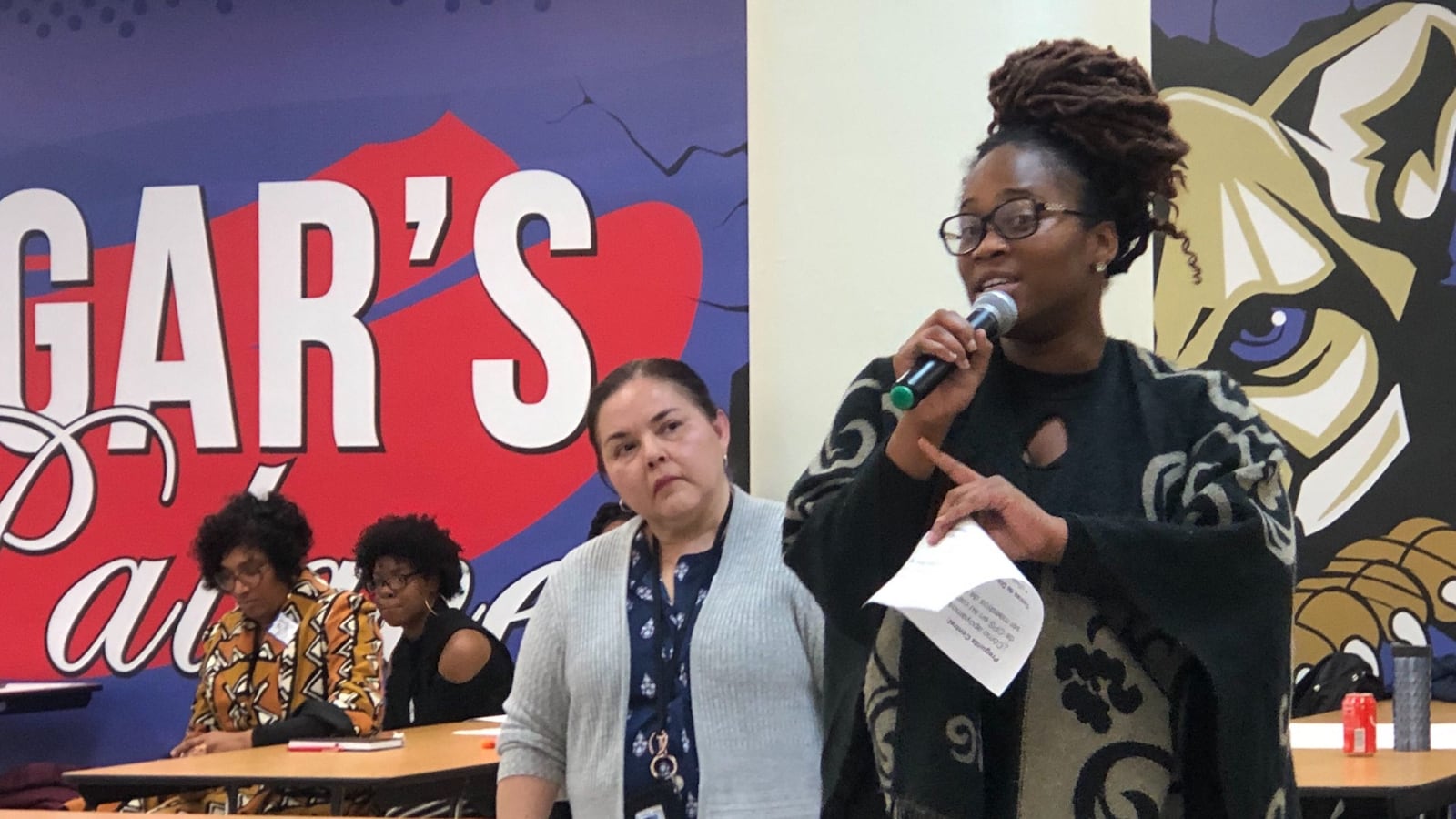One question surfaced again and again during the Chicago Board of Education’s first public meeting about better diversifying its teacher workforce: What about doing more to keep teachers from leaving?
“Take care of those who are already in the system,” Chicago Teachers Union Vice President Stacy Davis Gates asked of the district Monday. “Begin to see educators of color as partners and experts in the field.”
Retaining teachers of color is vital for a district where half the teachers are white and 89% of the students they teach are not. Since 2011, black teachers have left the district at higher rates than have teachers of other races. As a result, the city has lost a quarter of its black teaching force over a six-year period. At the same time, more than nine in 10 white teachers remained in the district, and the number of Latino teachers grew, according to a Chalkbeat analysis of district data.
It’s hard to zero in on just one reason for the losses of black educators, and a round of 2011 layoffs is the subject of ongoing litigation between the union and the district. That year, according to union calculations, 42% of 1,456 laid-off teachers were black, despite black teachers making up 29% of the total workforce.
Chicago schools face a crisis in teacher retention and a mighty struggle with hiring replacements — problems that may intensify as more teachers hit retirement age amid a national teacher shortage. Data on district hiring show that the city’s teaching corps is growing younger and whiter, as older black teachers retire and are replaced by younger newcomers who are predominantly white.
But the union pointed to other reasons the number of black educators has dropped dramatically, from teacher evaluations that tend to disadvantage black teachers to so-called turnaround schools where majority-black teaching staffs were let go in district-mandated overhauls for low-performing schools.
Retention is key
Both Chicago Mayor Lori Lightfoot and schools chief Janice Jackson have pledged to renew district efforts to build a workforce that better reflects its students. Key to delivering on that promise would be holding on to the teachers of color who have stayed with the district. Recognizing its need, the district has launched several recruiting and teacher-support initiatives, some with promising results.
“Research on the importance of a diverse teacher workforce is vast and quite definitive in its conclusions,” said Elizabeth Todd-Breland, a history professor and school board member spearheading the teacher diversity committee’s efforts. “All students benefit.”
A 2009 report from the University of Chicago Consortium on School Research showed the average Chicago school losing half its teachers every five years. More recent analysis isn’t available at the school level. At the district level, according to a decade’s worth of data provided by Chicago Public Schools, the district loses between 10% and 12% of its teachers each year, with fewer teachers — 8.3% — leaving in 2018-19. Another 5% of teachers switched schools but stayed within Chicago last year.
The drain in talent is a critical problem because research shows teacher quality is one of the most important factors in student achievement and growth, and beginning teachers are typically in the least effective stages of their classroom careers.

The problem, like many in Chicago, afflicts schools unevenly. Schools hemorrhaging enrollment also lose teachers faster. So do charters, although their teacher retention data is incomplete.
Data analyzed by Chalkbeat show that the 100 district-run schools that struggle most to keep teachers tend to serve predominantly black students, and have higher percentages of students who are in special education, from low-income families, or are homeless.
Teachers of all backgrounds are less likely to remain at black schools, but especially white and Latino teachers, who tend to stay at schools that are racially mixed or predominantly Latino.
Tackling those figures, the network has cultivated a residency program that provides mentors and underwrites graduate education. During the board’s meeting this week, officials touted the program, which counted 90 teacher residents this year, more than triple the 25 it had last year. By 2021, the district aims to have 150 residents in the program.
Residents are paid $35,000 per year and receive benefits as they work toward a master degree in education, boosting access for participants who couldn’t afford to forego a paying job to attend college. A bachelor’s program is also in the works, officials said.
One of the program’s recruits is Saleetra Garnett, a third-grade language arts instructor at King Academy of Social Justice in West Englewood.
Schools like King that serve black and economically disadvantaged students and struggle academically often have a hard time holding on to educators.
“But I felt the need to be where black kids are,” said Garnett, who taught in Chicago Public Schools seven years ago in a turnaround school — one where the campus was managed by the independent Academy of Urban School Leadership — then left for a Texas school district. “It just feels like I belong here.”
That Garnett, 32, has returned to Chicago Public Schools speaks to both her growth as a teacher and the district’s small triumph in luring her back. Just three years ago, King was losing nearly one-quarter of its teachers annually, more than the average district school.
Opportunity Schools
A program dubbed Opportunity Schools that helps with teacher recruitment and trains principals at the 60 toughest-to-staff schools helped lure Garnett back. The program also pairs new teachers with veterans, provides monthly coaching, and offers principals strategies to help hold on to teachers.
“We’ve been really trying to focus [principals] on some of the leadership moves that help create the kind of culture, the kind of career growth, and the kind of professional support for people that helps them stay in a job they otherwise would not want to stay in,” said Matt Lyons, the district’s chief talent officer.
But ongoing challenges facing Chicago schools also pose hurdles to recruiting staff. Schools like King can be a tough sell to prospective teachers, whose evaluations depend in part on how well their students perform, said Jasmine Thurmond, the principal at King.
“It’s heightened accountability, heightened expectations — but the same compensation,” she said. “Part of the interview process is differentiating between people just looking for a job versus those who want to do the work of supporting the development of children and their community. As a neighborhood school, our school reflects the community — the phenomenal things available as well as some of the challenges.”
At the same time, the district aims to boost the pipeline of future teachers of color, while also making moves to recruit more of the available educators. The district’s ambitious goal calls for hiring 3,000 more black and Latino teachers by 2024.
Since Jackson, the schools chief, announced that goal as part of her five-year vision early this year, it has hired 512, though that’s not a net increase. In the five years from 2013 to 2018, the district hired more than 3,500 black and Latino teachers, but that wasn’t enough to make up for the teachers who left.
Expanding Chicago’s residency program — an initiative gaining momentum in Illinois — is another way the district hopes to make it easier for paraprofessionals or other aspiring teachers to gain experience while working toward a degree.
Officials point out that the first cohorts of the residency program comprise mostly people of color, strengthening the possibility that tangible change is on the horizon.
To get results, though, there are some intractable problems that the district must deal with to boost retention: Research shows that poor school climate and low student achievement are two big reasons why teachers leave schools. But those problems are hard for a school to solve when it is constantly losing and replacing teachers year over year.
“The people who could be the greatest promoters of teaching our students don’t feel like they can honestly encourage people to get into this profession in this district,” Troy LaRaviere, president of the Chicago Principals and Administrators Association, said at the board’s committee meeting. “You have to change what teaching is like for the people doing it.”
Otherwise, the district runs the risk of losing more teachers of color like Chikamso Odume. She moved to Chicago to work for the district through Teach for America. After five years at Gary Comer College Prep in Grand Crossing, instructing eight classes of 35-45 students each, she said felt drained and opted to leave a workload she felt was unsustainable.
“I’m wondering why we’re focusing on the pipeline to get teachers when we can’t even keep them,” Odume said. “At the end of the day, all we’re doing is treating symptoms, and if the teachers aren’t staying, it doesn’t matter.”
Corrected: A previous version of this story included teachers who stay within the district but switch schools in teacher retention figures. The data has been updated to clarify which percentage leave the district each year.

